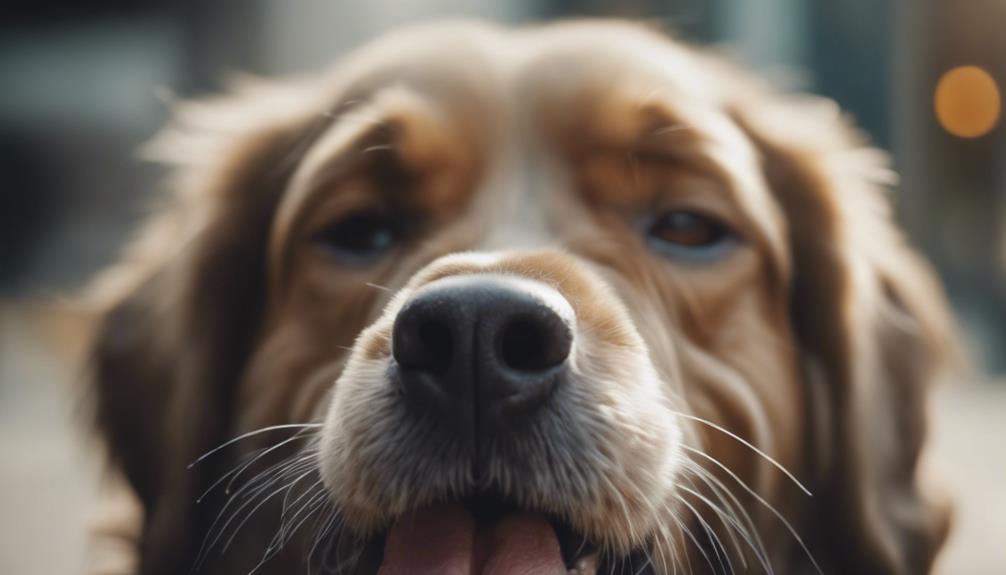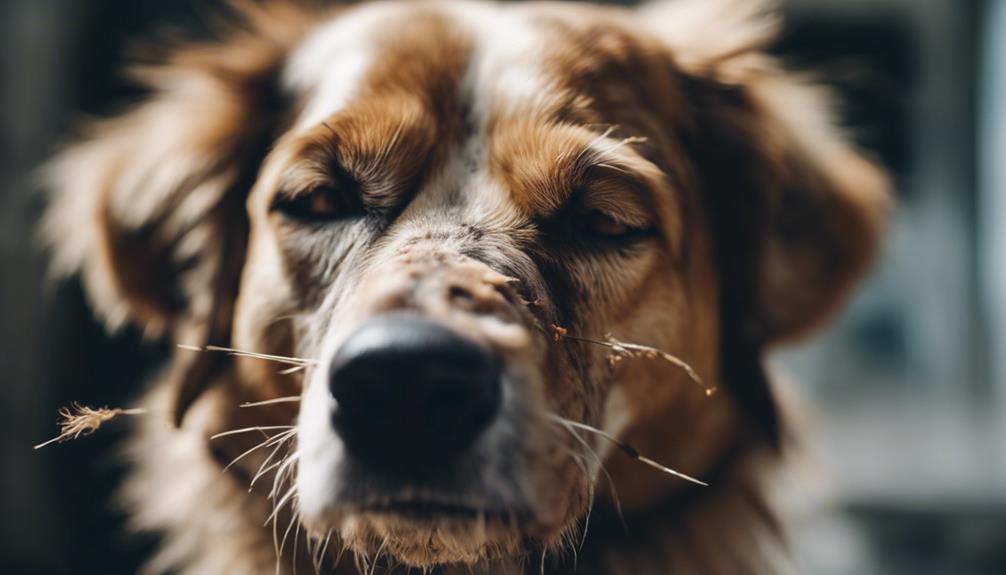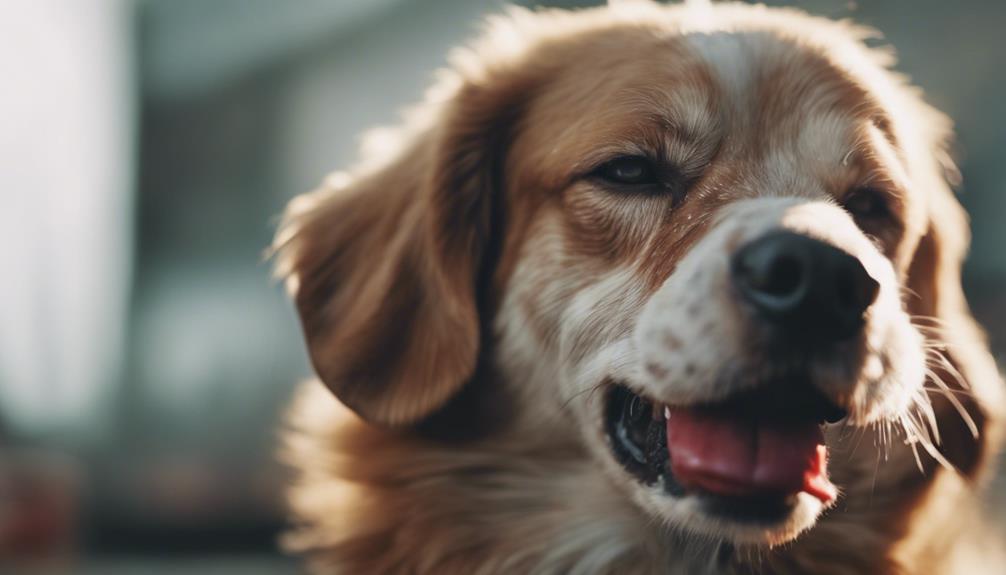Exploring the intricacies of why dogs engage in licking behaviors opens a window into the complex world of canine communication and well-being. From simple gestures of affection to addressing underlying health concerns, the act of licking holds a myriad of meanings that extend beyond mere surface-level interactions.
By unraveling the mystery behind this seemingly ordinary behavior, we can uncover a deeper understanding of our furry companions' needs and emotions. Stay tuned to discover the fascinating insights behind why dogs lick and how this behavior shapes their interactions with us and the world around them.
Key Takeaways
- Dogs lick to show affection, bond, groom, and clean wounds.
- Excessive licking can signal boredom, anxiety, or health issues.
- Managing licking with positive reinforcement and redirection is crucial.
- Regular veterinary evaluation is necessary for chronic licking leading to skin problems.
Affection and Bonding
The display of affection through licking is a fundamental way in which dogs establish and reinforce bonds with humans, other dogs, and pets. This behavior stems from a dog's natural inclination to communicate and connect with those they care about. When a dog licks you, it can be seen as a sign of trust, love, and submission.
Licking releases endorphins in the dog's brain, creating a sense of comfort and security. Additionally, licking serves as a form of social bonding within a pack or family unit. By engaging in licking behaviors, dogs strengthen their relationships with others, promoting social cohesion and emotional well-being.
Understanding the significance of licking in fostering connections can deepen the bond between dogs and their human companions.
Maternal Instinct
Nurturing behavior rooted in caregiving instincts is a prominent aspect of a dog's maternal instinct. Female dogs exhibit maternal behaviors not only towards their own puppies but also towards other animals, including humans.
Licking is a key maternal behavior that serves various purposes. It helps in cleaning newborn puppies, stimulates their bodily functions, and establishes a bond between the mother and her offspring. This instinctual behavior is crucial for the survival and well-being of the puppies, ensuring their cleanliness and promoting a sense of security.
Maternal instincts drive dogs to provide warmth, protection, and guidance to their young, demonstrating a strong sense of responsibility and care that is deeply ingrained in their nature.
Grooming and Hygiene

An essential aspect of canine care involves meticulous grooming routines to ensure optimal hygiene and physical well-being. Dogs engage in licking not only as a grooming behavior but also as a means of maintaining cleanliness and health. This grooming behavior serves several purposes, including:
- Removing dirt and debris from the fur
- Stimulating oil production for a healthy coat
- Checking for any abnormalities or parasites
Regular grooming through licking is a natural instinct that helps dogs stay clean and healthy. However, excessive licking can sometimes indicate underlying health issues that may require veterinary attention. Monitoring your dog's grooming habits can provide valuable insights into their overall well-being.
Healing and Comfort
When addressing the topic of aiding dogs in finding comfort and healing, understanding their natural instincts and behaviors is essential. Dogs often lick themselves or others as a way to heal wounds, provide comfort, and alleviate discomfort. This behavior can have a soothing effect on dogs, both physically and emotionally. By recognizing the reasons behind their licking habits, pet owners can better assist their furry companions in times of need.
| Healing and Comfort | |
|---|---|
| Natural Instincts | Dogs lick wounds to clean and soothe |
| Emotional Comfort | Licking can provide emotional relief |
| Soothing Effect | Licking helps alleviate discomfort |
Indications of Health Issues

Detecting indications of health issues in dogs through vigilant observation of their licking behavior is crucial for maintaining their overall well-being. Excessive licking can serve as an early warning sign of underlying health issues. It is essential for pet owners to pay attention to any changes in their dog's licking habits to ensure prompt intervention and treatment.
- Changes in frequency or intensity of licking
- Presence of sores, redness, or irritation in licked areas
- Sudden onset of excessive licking without apparent cause
Boredom and Anxiety
In understanding the reasons behind excessive licking in dogs, addressing the underlying factors of boredom and anxiety is essential for effective behavior modification. Dogs may lick excessively when they are bored or anxious, using this behavior as a coping mechanism.
Boredom can stem from lack of mental stimulation, inadequate physical activity, or being left alone for extended periods. On the other hand, anxiety in dogs can manifest through various behaviors, including excessive licking.
It is crucial for dog owners to recognize signs of boredom and anxiety in their pets to provide appropriate mental and physical stimulation, companionship, and training to alleviate these underlying issues. Proper enrichment, exercise, and positive reinforcement techniques can help reduce excessive licking behaviors associated with boredom and anxiety.
Skin Problems Warning Signs

Common indicators of skin problems in dogs include visible redness, irritation, or abnormal lesions on the skin. Skin problems can manifest due to various reasons and may require veterinary attention to prevent further complications. It's essential for dog owners to be vigilant and recognize warning signs early to ensure prompt treatment.
- Persistent itching or scratching
- Hair loss or bald patches
- Foul odor emanating from the skin
These signs may indicate underlying issues that need to be addressed promptly. Seeking professional help and following the veterinarian's advice can help manage and alleviate your dog's skin problems effectively.
Self-Inflicted Wounds
Skin problems in dogs, such as persistent itching or scratching, can often lead to self-inflicted wounds caused by excessive licking behavior. When dogs excessively lick certain areas, they can create wounds that may worsen if not addressed promptly. These self-inflicted wounds are a result of the dog's natural response to alleviate discomfort or irritation. To help visualize the impact of self-inflicted wounds from excessive licking, consider the following table:
| Effects of Self-Inflicted Wounds from Excessive Licking |
|---|
| Rapid deterioration of skin condition |
| Increased risk of infection |
| Delayed wound healing |
| Potential need for veterinary intervention |
Understanding the connection between skin problems, excessive licking, and self-inflicted wounds is essential for proper management and care of your dog.
Importance of Monitoring

Regular monitoring of your dog's licking behavior is crucial for early detection of any underlying health issues. By keeping a close eye on how often and intensely your dog licks, you can promptly address any potential concerns that may arise. Monitoring your dog's licking habits can provide valuable insights into their well-being and help prevent any health problems from escalating.
- Early Detection: Identifying changes in licking patterns can signal developing health issues.
- Preventative Care: Monitoring allows for timely intervention and preventive measures.
- Veterinary Consultation: Regularly tracking licking behavior enables informed discussions with your veterinarian.
Training Techniques
Utilizing positive reinforcement training methods can effectively address and modify excessive licking behaviors in dogs. Positive reinforcement involves rewarding desired behaviors, like refraining from excessive licking, with treats, praise, or toys. Consistent training and redirection techniques can help manage and decrease excessive licking habits. Below is a table outlining some effective training techniques to curb excessive licking behaviors:
| Training Techniques | Description |
|---|---|
| Positive Reinforcement | Rewarding desired behaviors to discourage excessive licking. |
| Redirection | Redirecting licking behavior to toys or treats. |
| Consistent Training | Regularly reinforcing appropriate behaviors. |
| Understanding Behavior | Identifying the reasons behind excessive licking. |
| Veterinary Examination | Seeking professional evaluation for chronic licking issues. |
Health Concerns

To address potential health concerns related to excessive licking in dogs, veterinary evaluation is crucial for identifying and managing underlying issues. Excessive licking can indicate various health problems that require professional attention. Here are key health concerns associated with excessive licking in dogs:
- Skin problems such as dermatitis or infections
- Allergies leading to skin irritation
- Presence of fleas or other parasites
Prompt veterinary assessment is necessary to determine the root cause of excessive licking and provide appropriate treatment. Monitoring your dog's licking behavior and seeking veterinary advice promptly can help prevent worsening health issues.
Behavior Modification
Behavior Modification in dogs can be effectively achieved through targeted training methods and consistent reinforcement techniques. By understanding the reasons behind excessive licking, pet owners can implement strategies to modify this behavior successfully. Positive reinforcement training plays a crucial role in curbing excessive licking habits. Redirecting the dog's focus by offering toys or treats can help manage and reduce excessive licking. Consistent training is vital for modifying your dog's behavior effectively. Veterinary examination is essential for dogs exhibiting chronic licking behaviors that lead to skin problems. The table below summarizes key points for behavior modification in dogs:
| Behavior Modification Strategies | Description | Effectiveness |
|---|---|---|
| Positive reinforcement training | Rewards good behavior with treats or praise | Highly effective |
| Redirecting focus | Distract dog from licking by offering toys or treats | Moderately effective |
| Consistent training | Establishing a routine to discourage excessive licking | Essential for success |
Can Excessive Barking and Licking in Dogs Be Related to Anxiety or Stress?
Many dog owners wonder about the connection between excessive barking and licking in dogs and anxiety or stress. An expert insight into dog barking suggests that these behaviors can indeed be signs of underlying emotional issues in dogs. It’s important to monitor and address these signs to ensure the well-being of your furry friend.
Conclusion
In conclusion, understanding the reasons behind why dogs lick is crucial for pet owners to ensure the well-being and happiness of their furry companions.
By recognizing the various purposes of licking, such as affection, grooming, and addressing health issues, individuals can better care for their dogs.
Monitoring licking behaviors, implementing training techniques, and seeking veterinary intervention when necessary are essential steps in managing and addressing this common behavior in dogs.




